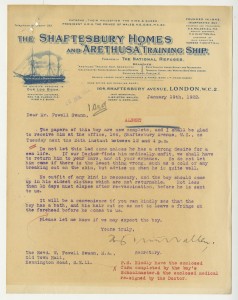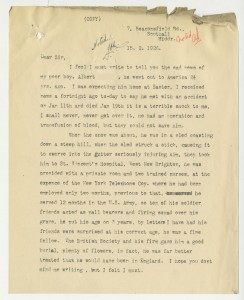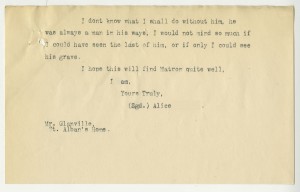Today we have a guest post written by one of our project volunteers, Ella St John-McAlister.
***
Reading Alfred’s case file left me with the impression that he had been a bright and ambitious boy. He came into the care of The Children’s Society (then known as The Waifs and Strays Society) in 1916. Unlike the subjects of most case files I come across (I am researching children’s illnesses and their medical history) he was a healthy boy. This was in spite of Alfred’s father having passed away when Alfred was five years old and his mother being jailed twice for neglecting her children – although the nature and extent of her “immoral life” is unclear.
We know little about Alfred’s life before he entered The Children’s Society except that he had six brothers and sisters, one of whom was the illegitimate child of a “sergeant who was called to France and killed”. It was for neglecting this child that Alfred’s mother was first jailed in 1916. We also know that all of Alfred’s brothers and sisters were in the workhouse: a desperate, destitute sanctuary for those who were unable to support themselves. Something of Alfred’s character comes across in the application form submitted to The Children’s Society, where it states that Alfred played truant despite being “quick and sharp”.
Alfred was admitted into The Children’s Society’s care at the age of eight in 1916, and at the age of 14 he applied for an apprenticeship on a Navy training ship called the Arethusa, indicating a desire to travel and a willingness to “obey his [the Commander’s] and [his successors’] lawful commands”.
The fact that he was allowed to join the ship indicates that he must have been at a certain level of health because there were strict requirements on the height and health of those who joined:
Age: 13½-15 Height: At least 4ft. 8 in. (without boots.)
Age: Over 15 Height: At least 4ft. 10½in. (ditto.)
Once on board a typical daily menu aboard the Arethusa might have looked something like this:
- 1lb soft bread
- 8oz biscuit
- 7oz fresh meat
- 8oz potatoes
- 3/4oz cocoa
- 1/8oz tea
- 2/3oz sugar
A pretty meagre and dour menu by today’s standards. After he joined the Arethusa Alfred vanishes from view. Sadly, it is a letter from Alfred’s mother reporting his death in 1926 at the age 18 that enables us to piece together an idea of his last years.
Dear Sir,
I feel I must write to tell you the sad news of
my poor boy, Albert [middle initial, surname], he went out to America 2 ½
yrs. ago. I was Expecting him home last Easter, I received
news a fortnight ago to-day to say he met with an accident
on Jan 11th and died Jan 19th it is a terrible shock to me,
I shall never, never get over it, he had an operation and
transfusion of blood, but they could not save him.
When the snow was about, he was in a sled coasting
down a steep hill, when the sled struck a stick, causing it
to swerve into the gutter seriously injuring him, they took
him to St. Vincent’s Hospital, West New Brighton, he was
provided with a private room and two trained nurses, at the
expence [sic] of the New York Telephone Coy. [Company] where he had been
employed only two months, previous to that, he
served 12 months in the U.S Army, so ten of his soldier
friends acted as ball [sic] bearers and firing squad over his
grave, he put his age on 3 years, by letters I have had his
friends were surprised at his correct age, he was a fine
fellow. The British Society and his firm gave him a good
burial, plenty of flowers, in fact, he was far better
treated than he would have been in England, I hope you don’t
mind me writing, but I felt I must.
I don’t know what I shall do without him, he
was always a man in his ways, I would not mind so much if
I could have seen him the last of him, or if I only I could see
his grave.
I hope this will find Matron quite well,
I am,
Yours Truly,
(Sgd. [Signed]) Alice [middle initial, surname]
It is a sad ending to what looked as if it could have been a very promising future, but this letter also holds some fascinating information. The reference to a blood transfusion is the first instance we have found of this procedure in The Children’s Society’s case files. The technology behind the procedure for extracting, storing, and transfusing blood was still developing at the time Alfred received his transfusion.
The first recorded, successful attempts at blood transfusions happened in the 1600s, although these experiments used animals. Even in the late 1800s blood transfusions were shunned by medical professionals and considered extremely risky. In fact, in Britain in the early 20th century, surgery textbooks referred to blood transfusions as a quaint relic of medical history. If only they had known! However, just as the idea of blood transfusions was being cast aside, the discovery of different blood types was made. The medical and surgical needs brought on by World War I also acted as a catalyst for the idea of blood transfusions gaining respectability within the medical field.
What makes Alfred’s story so exciting is that in 1926 when he received his blood transfusion, the first hospital blood bank in the United States had not even been established. Whilst blood was donated voluntarily in Britain from the early 1920s onwards, donors were being paid up to $100 for a pint of blood in the U.S., meaning Alfred’s procedure could have been quite a costly one.
Although Alfred’s case file is fairly slender, it contains useful information on what it was like to be a child at that time and a child under The Children’s Society’s care, and also on an important medical advance, one many of us might take for granted today.



